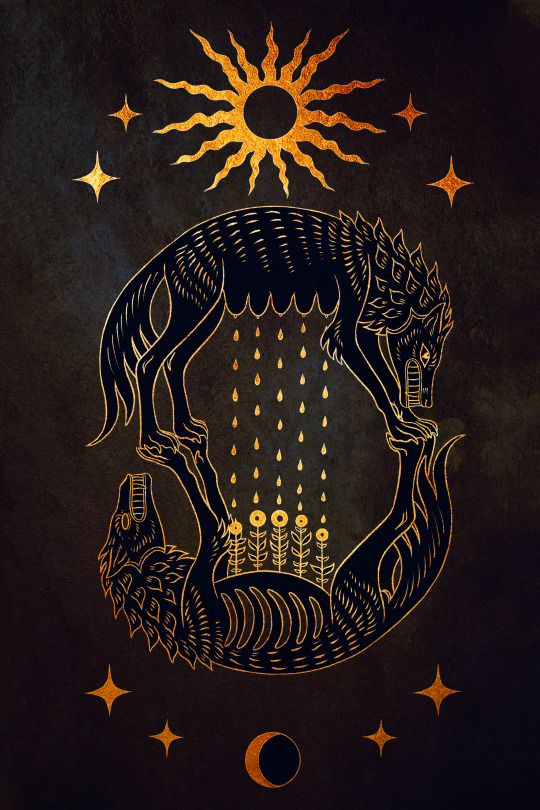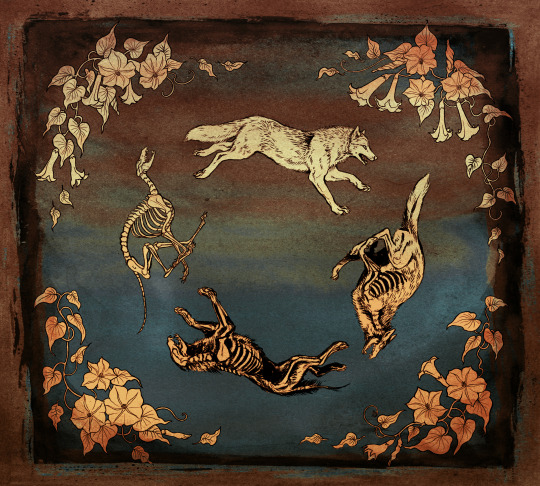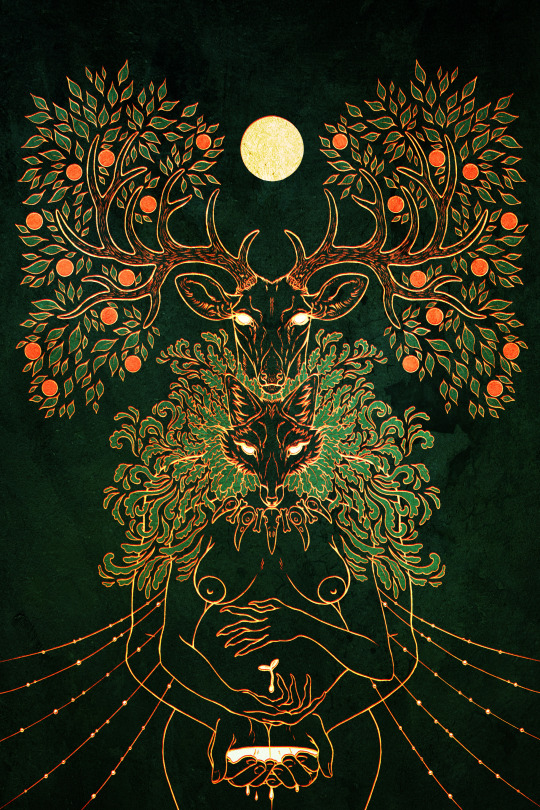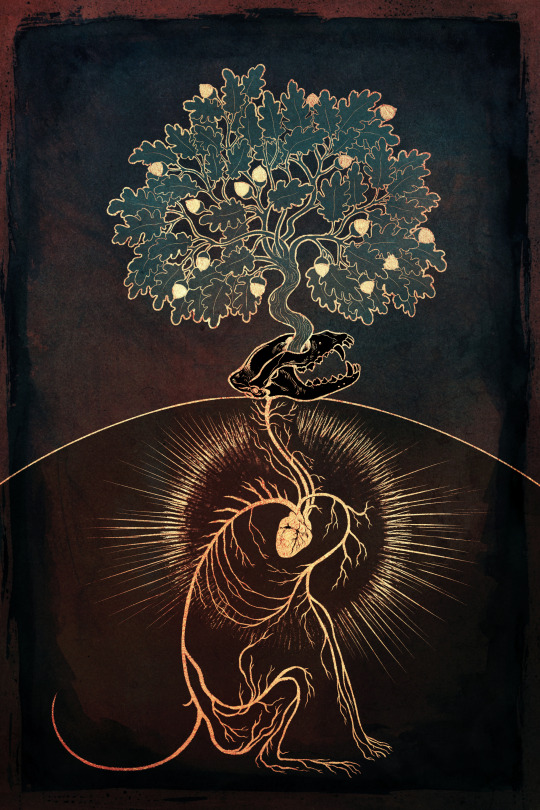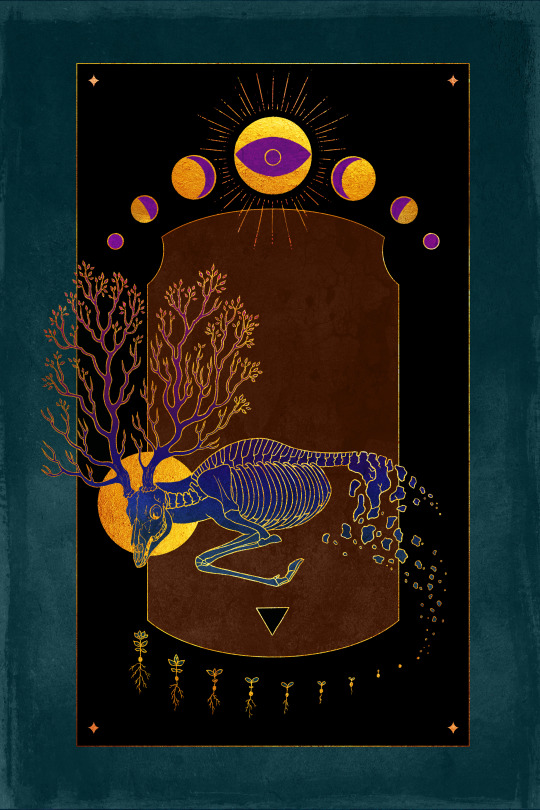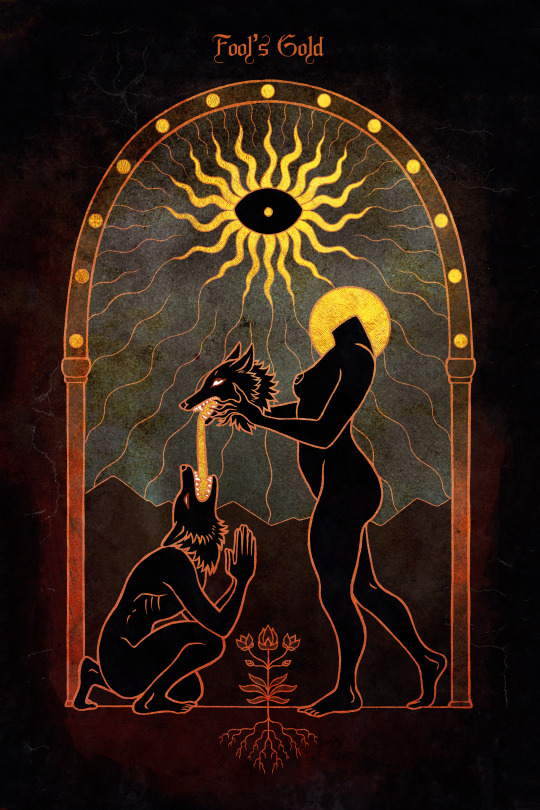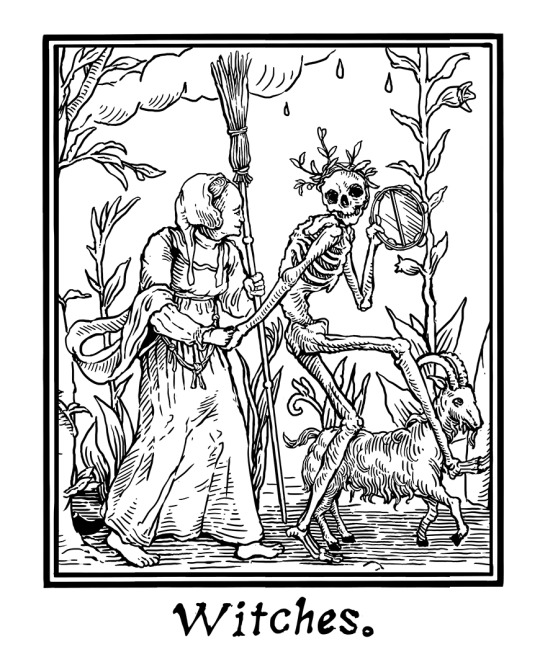A pagan living in Shanghai | Sideblog for my witchy inclinations.
Don't wanna be here? Send us removal request.
Text








I saw a post for the Hellenic pantheon by @sarahsspirits and really liked it and had to make my own versions for the Norse pantheon.
2K notes
·
View notes
Text
Secular Celebrations - Yule
At the very end of the Gregorian calendar comes the winter solstice and Yule. Technically, this is the FIRST holiday on the Wheel, since Samhain is the boundary between the old year and the new. But since most of us have to follow the January to December schedule in our day-to-day lives, we’ll end with Yule.
The winter solstice is a time when we focus on hunkering down and staying warm. We look to the homestead, we take care of our families, and we make sure our communities are surviving the winter as comfortably as possible. This is one of the times that the Wild Hunt was said to ride, their presence indicated by howling winds and stormy nights when it wasn’t safe to venture out. All manner of entities personifying hunger and cold and death stalk the landscapes of winter mythology, so we fortify our homes however we can and indulge in a little midwinter revelry to keep ourselves going until the spring.
Decorate with pine bunting, pine cones, holly, mistletoe, snow symbols, fairy lights, electric candles, ribbons, streamers, local fauna active during winter, whatever you like. There are plenty of Christmas wreaths out there, so don’t be afraid to make a witchy one with a big old star in the middle. Make sure that any ACTUAL foliage is kept away from the pets, and of course, observe fire safety for any lights you put up. Way too many house fires are caused by electrical shorts in holiday lights, so be extra careful. Do NOT plug an extension cord into a power strip. And go easy on the plastic glitter. Anathema to some, I know, but the more of that we can keep out of the waste cycle and the water system, the less will end up in the oceans.
If you have a fireplace, you can burn a symbolic log “to drive the cold winter away.” Or, if you only have a cauldron or a burning bowl, you can find an outdoor space to burn some twigs and incense for the same purpose. Or you can light some candles with appropriately wintry scents. Or, if you can’t burn anything at all, an LED candle left alight overnight on the altar should do the trick. The whole idea is to symbolize keeping warmth in the home, keeping the dark and the cold at bay, and keeping the home fires literally burning for those who must be elsewhere. However you manage this is fine.
Spend time with your near-and-dear, if you can. Eat good food, drink good wine, and do cozy things. Share treasured memories, and tell stories. Fun fact: Yule and Christmas are another traditional time of year for ghost stories, so feel free to pull those out again. If there’s a family tradition of feasting and gift-giving, lean into it. There are a lot of Christian traditions from Christmas that have made their way into the secular sphere. Sure, they still have some religious associations, but I know plenty of atheists who still exchange presents because it’s FUN. You can also give gifts to others by contributing to charitable organizations, donating to clothing drives and food pantries, or through random acts of kindness to those who need it.
Charity and compassion should be emphasized during this time of year. I mean, you should be charitable and compassionate ALL year when you can manage it, that’s just common decency. But especially when it’s cold and people are feeling that lack of money or resources and we’re surrounded by all these super-capitalistic ad campaigns telling us that our love for others is worth only as much as the kitchen appliances and diamond jewelry we put under the tree….yeah, maybe bring something a little more altruistic to the table. It doesn’t have to be huge, it doesn’t have to be performative. Just look for those opportunities to help someone out or make their life a little easier. You’ll know them when you see them.
If you’re crafty, pull out those projects you’ve been saving for a rainy day. We often spend a lot of time cooped up in the house during cold weather, the more so in 2020 with the various lockdowns, so why not turn it into something productive? Fix something, create something new, work on that scarf you’ve been meaning to finish since last winter. Make a pinecone feeder for the local birds, or scatter some nuts and dried berries for any critters that happen to be out and about. Do winter crafts with your kids to keep them occupied, if they happen to get bored of watching Frozen 2 for the hundredth time this week. (Hey, I only have nieces and a nephew, but I’ve still heard the horror stories.)
Let me pause a moment to address the proverbial elephant in the room. And this MIGHT be dipping a toe into the religion pool, but it’s an issue that a lot of us face. Late December can be a tough time for witches who were raised Christian but are, for one reason or another, disconnected from the faith or the Church at present. There’s the constant symbolism in music and decorations all around, pressure from our friends and families, people gnashing their teeth about red coffee cups, and so on. And we’re not even going to talk about the annual arguments over who stole whose holidays. If you know me, you know exactly how salty I can get on the topic, and we don’t have time for that today. This is about finding ways to celebrate, not my personal rage over people who don’t understand the difference between conflation and syncretism, and can’t be arsed to read history that doesn’t come from-...
Ooooo deep cleansing breath. Come on, Bree, you promised. (-hiss- I LIED.)
ANYWAY. Yule is a time when it might be worth remembering literally anything positive that came out of your experience with Christianity. Some of us have it, some of us don’t, that’s purely a personal matter. Some of us miss the carols, okay? There can be a lot of nostalgia involved in the season that’s disconnected from whatever trauma or differences in belief led to that split. And if you want to pause and remember that fondly, that’s okay. I will fully confess to singing along to Christmas hymns on the radio in my car at top volume because that’s a big part of the season for me and always has been. Heck, I might even attend a service at the local Unitarian church. They’re nice and non-denominational and they focus much more on the meaning behind the season than any particular holiday. So if you feel the need for that fellowship, see if there’s a UU church near you, or a virtual service online. There’s nothing wrong with revisiting your roots.
Moving back into witchcraft territory, you can collect clean snow and icicles to melt for winter moon water. This isn’t really much different from moon water you’d make at any other time of year, but it’s another method of gathering the base material. Also, icicles are great for any water you’re setting aside for more aggressive or protective purposes. The fact that they look like hanging spears isn’t lost on me.
Check your household protections and see if anything needs shoring up. Like I said, I cast my wards every year at Samhain, but they always seem to need a bit of detail work by the time Yule rolls around. Or heck, you might find Yule a more appropriate time to perform that casting, or maybe you refresh your wards at every holiday, who knows. Whatever works for you, as long as you remember to do it at some point. Cleanse your thresholds and the corners of your home, at the very least, just for good measure. But don’t go sweeping anything out the door. That’s sweeping away your good luck for next year.
And speaking of New Year’s, if the year you’ve had has been particularly….well, like the year we’ve had, you can also burn the year in effigy and cleanse with incense for a fresh start. Just write it on a piece of paper and burn that S.O.B. in the cauldron. While you’re at it, you can symbolically burn lingering worries, bad habits, bad memories, and regrets with either candle flame or a burning bowl. And yes, that includes all those negative things you think about yourself that you wish would go away.
And finally, reflect on the year as a whole, with all the joys and lessons it’s brought you. What memories have you made? What has brought you joy? What do you regret? What have you learned? What skills have you developed and how will you use them? What improvements do you still wish to make? And what do you want to do with the coming year?
And around and around it goes….
Like I said at the beginning, this is by no means exhaustive. These are just some basic ideas to get you started. You can make your own celebrations and your own traditions as you, either by building off of existing ones or by creating something new. As long as it has meaning to you and marks the occasions you deem important in ways that are fun and festive, it’s all good. This is something I’d love to see more often as a discussion - personal traditions, things that are unique to families or particular regions or individual witches, all the places they intersect, and all the various ways that we celebrate ourselves and each other and our craft.
- Hex Positive, Ep. 011 - Secular Celebrations (November 1, 2020)
Other Posts In This Series:
Imbolc
Spring Equinox
Beltane
Midsummer
Lughnasadh
Autumn Equinox
Samhain
Yule
2K notes
·
View notes
Photo
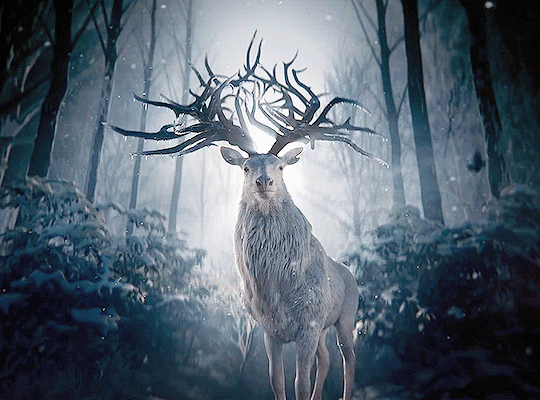
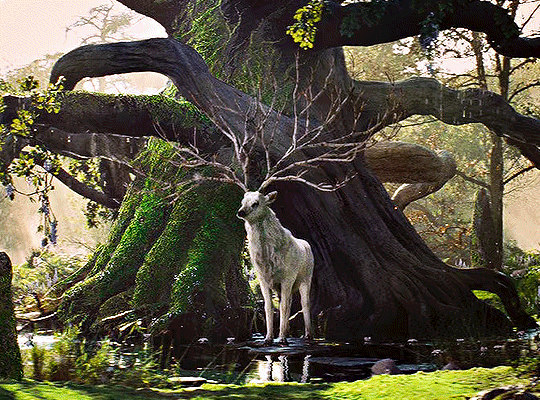
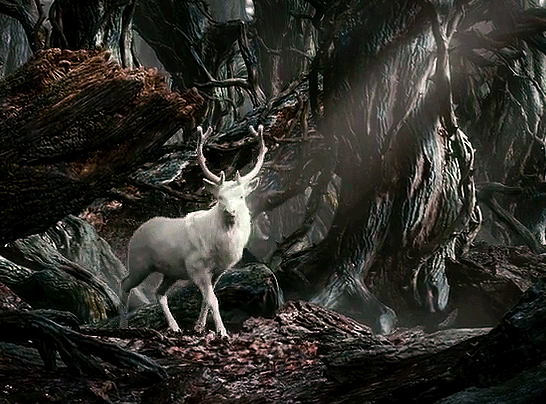
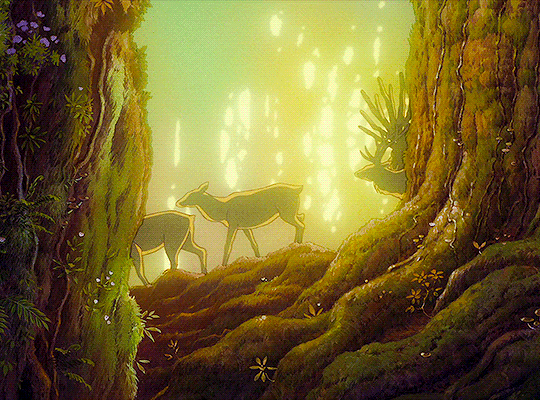

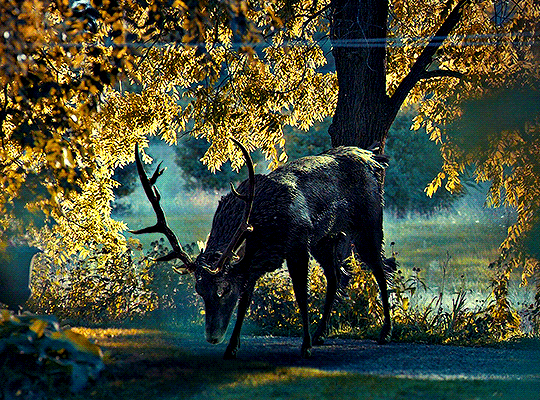
magic or mythical deer in film and tv (see also: fucked up deer)
1. Shadow and Bone (2021) 2. Snow White and the Huntsman (2012) dir. Rupert Sanders 3. The Hobbit: The Desolation of Smaug (2013) dir. Peter Jackson 4. Princess Mononoke (1997) dir. Hayao Miyazaki 5. Harry Potter and the Prisoner of Azkaban (2004) dir. Alfonso Cuarón 6. Hannibal 1x03 - “Potage” (2013) dir. David Slade
14K notes
·
View notes
Text
🍯Litha herbal honey cookies🍯
1 & 3/4 cups of flour
¾ C. softened butter
¼ C. honey
¼ cup brown or cane sugar
1/2 teaspoon minced thyme
1/2 teaspoon lavender buds
1/2 teaspoon minced rosemary
1/2 teaspoon minced sage
pinch of salt
Icing:
3 teaspoons milk
1 cup icing sugar
a wee bit of grated lemon rind.
Coloring
Combine your milk and icing sugar. Slowly add in your colouring and mix until you find the desired colour/consistency
Preheat Oven to 300F (150°C)
Beat flour, sugar and soft butter together until creamy.
Slowly drizzle in honey while beating until mixture pulls together.
Add minced herbs and petals, mix well through the dough.
Divide into four balls and chill for an hour or so.
Roll out and cut into round shapes. Add flour as needed.
Bake at 150°C for 10-15 minutes.
Let cool.
Add icing on top
Decorate using the flowers and herbs of the sun: petals of calendula, lawn daisies, St. John’s Wort, rose, or sprigs of rosemary, thyme and sage.

170 notes
·
View notes
Text
“Most witches don’t believe in gods. They know that the gods exist, of course. They even deal with them occasionally. But they don’t believe in them. They know them too well. It would be like believing in the postman.”
— Terry Pratchett, Witches Abroad (via discworldquotes)
18K notes
·
View notes
Text
Still waiting for the day where I can just listen to pagan metal without any second thoughts and without having to do excessive research beforehand, to make sure the band members aren't fucking nazis.
Those stupid motherfuckers really gotta take the best fucking music genres from us as well.
261 notes
·
View notes
Photo



ƁELTANE (Lá Bealtaine)
Beltane, one of four Gaelic seasonal festivals, is the Celtic May Day. Historically widely observed throughout Ireland, Scotland and the Isle of Man, Beltane used to mark the beginning of summer and was when cattle were driven out to the summer pastures.
Rituals were performed to protect the cattle, crops and people, and to encourage growth.
Special bonfireswere kindled, and their flames, smoke and ashes were deemed to have protective powers. The people and their cattle would walk around the bonfire, or between two bonfires, and sometimes leap over the flames or embers. All household fires would be doused and then re-lit from the Beltane bonfire. These gatherings would be accompanied by a feast, and some of the food and drink would be offered to the aos sí (spirits). Doors, windows, byres and the cattle themselves would be decorated with yellow May flowers, perhaps because they evoked fire.
In some parts of Ireland, people would make a May Bush: a thorn bush decorated with flowers, ribbons and bright shells. Holy wells were also visited, while Beltane dew was thought to bring beauty and maintain youthfulness.
Bonfires All hearth fires and candles would be doused before the bonfire was lit, generally on a mountain or hill.
In the 19th century, the ritual of driving cattle between two fires was still practised across most of Ireland and in parts of Scotland. Sometimes the cattle would be driven “around” a bonfire or be made to leap over flames or embers. The people themselves would do likewise.
In the Isle of Man, people ensured that the smoke blew over them and their cattle.
When the bonfire had died down, people would daub themselves with its ashes and sprinkle it over their crops and livestock. Burning torches from the bonfire would be taken home, where they would be carried around the house or boundary of the farmstead and would be used to re-light the hearth.
From these rituals, it is clear that the fire was seen as having protective powers. As a matter of fact bonfires were meant to mimic the Sun and to “ensure a needful supply of sunshine for men, animals, and plants”, but they were also meant to symbolically “burn up and destroy all harmful influences”.
Food was also cooked at the bonfire and there were rituals involving it. Everyone present would take an oatmeal cake, called the bannoch Bealltainn or “Beltane bannock”. A bit of it was offered to the spirits to protect their livestock (one bit to protect the horses, one bit to protect the sheep, and so forth) and a bit was offered to each of the animals that might harm their livestock (one to the fox, one to the eagle, and so forth). Afterwards, they would drink the caudle.
Maypole It is a tall erected wooden pole around which maypole dances take place.
The practice had become increasingly popular throughout the ensuing centuries, with the maypoles becoming “communal symbols” that brought the local community together: even poorer parishes would join up with neighbouring ones in order to obtain and erect one.
As revived, the dance consisted of pairs of boys and girls (or men and women) stand alternately around the base of the pole, each holding the end of a ribbon. They weave in and around each other, boys going one way and girls going the other and the ribbons are woven together around the pole until the merry-makers meet at the base. There are also more complex dances for set numbers of dancers, involving complicated weaves and unweaves.
In some regions, a somewhat different Maypole tradition existed: the carrying of highly decorated sticks. The sticks had hoops or cross-sticks or swags attached, covered with flowers, greenery or artificial materials such as crepe paper. Children would take these hand-held poles to school on May Day morning and prizes may be awarded for the most impressive. This tradition is known as garlanding, and was a central feature of May Day celebrations in central and southern England until the mid-19th century.
501 notes
·
View notes
Text
An Altar to the Unknown Gods
I had recently left vc with someone who I value a lot. During the vc, a thought drifted to me: Are there any unknown gods in my life that bestow gifts, that keep watch over me, that wish me the best, etc in my life? And I divined. I got a yes.
I tried to discover who, but got a distinct no. Divination told me to not go searching. I cannot know as of now. Honestly — that’s okay. I do not absolutely need to know who. If they do not want to be revealed — that’s okay too. Revealing their existence to I is their choice in the end.
All I know is that there is someone there who looks out for me. I do not know who, but they do. For their service I wanted to spoil them with my small gifts, but how can you worship an unknown god? When you do not know the name of someone, how can you bring gifts? But then, I was suggested something life-changing:
An altar to the unknown gods.
It was a beautifully brillant suggestion. I could even give simple offerings, such as the fruit juice I make, flowers, etc. All the things I do can be done for the unknown gods. Unknown gods can still receive worship. You may not know them, but gifts can still be abundant. An altar is just one aspect to worship, so my mind drifted and I thought of many things to do for them. One suggestion has changed my praxis and thought process so quickly and so positively.
I personally plan to gather some slabs, rocks — whatever, leave a few nice things on there, and address the unknown gods. I shall hope what I can give will be good and that they’ll like it. I believe they will be gracious if I give something they do not like. I do not know their names nor who they are, so I cannot know.
When addressing them, I’ve got some ideas. These are some of the ones I plan to use:
To the unknown gods, that keep watch over me and give me gifts even if I cannot speak your name…
Unknown gods, who are kindly to me and my efforts, but whom I do know by name nor by nature…
Gods who I do not know, the unknown gods, gracious and loving…
If you wish to build an altar to the unknown gods in your life, it’ll have to be simple. Let your intuition guide you in doing so. Here’s a list of ideas for building one:
make the altar a stone slab
add flowers and the likes
shiny rocks such as common quartz
Sticks and other trinkets
Things that are valuable (gold, silver, etc).
An offering bowl
Intuition based images/items/etc.
You can also simply leave offerings to them. Maybe pick a day in your calendar(s) and say ‘this is for the unknown gods’. Prayers are an option, possibly even devotional acts. You cannot tailor the act to anything in particular as they are unknown — but it’s the thought that counts.
My ideas for offerings to the unknown gods are:
Flowers. They’re a simple and kind token of affection.
Water. There’s nothing more common and life-giving as water.
Fruit. The harvest from the trees is common to many.
Grains. The harvest is common to many.
Meals. The food we prepare is a kind gesture.
Honey. The gold from bees is prized by many across time.
Alcohol. The many kinds of alcohol have been prized across time.
There’s a thousand things to do for the unknown gods. In a strange way, knowing nothing gives you everything. There’s no pressure to be had when honouring those unknown.
Some may ask why you would worship unknown gods. Personally, I find it rather tranquil. I don’t know and that’s the beauty of it. If I do know one day, I’ll rejoice. But if I never do — I’ll just have to accept it. They possess a love for me and I appreciate it, even though I can’t even utter their name. I do not know why they give their love and gifts. I just hope that they know I care for them too. It’s been such a short time but they have made me realise that love does not need a personal name to attach that love to.
Names are important yet I do not feel the need to call this unknown god or unknown gods a defined name that I crafted myself. ‘The unknown gods’ is a term that fills that exact role — I don’t need to create something new when I have that simple phrase.
When it comes to the unknown gods, it reminds me of history. There’s many gods that simply aren’t attested anywhere anymore — they’re lost to history. There’s many gods that are only mentioned once or twice that we know nothing of. It’s a sad reality, but it’s our reality. We have to deal with it. Not all things can be known.
I do not know if they will ever reveal themself (or themselves) to me. But I can say thank you. I can cry to the unknown gods if I need. I don’t know them, but they know me. They may even love and adore me, but I do not know. So, cry to the unknown gods sometime. Leave an offering or two, won’t you? They’re unknown gods.
wordpress link
606 notes
·
View notes
Text
Since this fucking guy:

Has been front and center in every news article I’ve been reading, let me just reiterate something.
Norse Paganism has no room for fascists, nazis, Trumpers, alt-righters, Proud Boys, or whatever else they call themselves.
They are the lowest of the low, and Niddhogr will gnaw on their bones for all eternity.
He is a cowardly and foolish fanboy of the Viking Age, and an embarrassment to us all.
9K notes
·
View notes
Text
Pagan holiday’s are fun cus no one can figure out if they should preface their holiday greatings with “happy” “merry” or “blessed”
112K notes
·
View notes
Text
Why Yule Needs to Stay Creepy
“…There’ll be scary ghost stories and tales of the glories of Christmases long, long ago…”
So I have been thinking about our Contemporary conceptualization of the Christmas season a lot lately and it’s kind of interesting. So many things we associate with Christmas – Christmas trees, greeting cards, Santa Claus, his reindeer and elves, gift-giving in general – all of these things came into vogue in the 19th Century and are very sticky-sweet, in my opinion. They’re lovely, but not filling. If we just scratch the surface of the Christmas we know and love and peek back into its history, we find something much meatier.
Before the cheerful Christmas tree, a number of other plants were associated with Christmas. The holly, associated with sacrifice and the blood of Christ, and the parasitic mistletoe, associated with the death of Baldur in Norse mythology – these were the plants associated with Christmas before the Christmas tree became the standard.
Also, the Yule log. The Yule log, meant to provide light on the darkest night of the year, was a magic charm in and of itself. If it did not burn through the night, it would be a terrible omen. By watching the fire and coals of the Yule log, one could also predict who would give birth and who would die in the coming year.
When our simple Santa Claus is reduced to his predecessors, one is left with Odin, ancient Norse God of battle, Saint Nicholas, the canonized former bishop of Turkey, and Father Christmas, the hard-drinking gluttonous representation of holiday merriment. And all of them brought ghastly friends – Odin, the spirits of the Wild Hunt and Saint Nicholas, his helpers (including Knecht Rupert, Krampus, etc.). Father Christmas, more of a personification of the season than a night visitor, undoubtedly brought many hangovers.
Before stories about reindeer, snowmen, or things of that ilk, there were ghost stories. Charles Dickens did not invent the Christmas ghost story in “A Christmas Carol,” but popularized an already-existing folkloric trend. If we look to the old tales of Christmas, we find stories about witches that rode the night air, cursing the birth of the Savior. There are stories about fairies, ghosts, and Devils that wreak havoc, frightening livestock and damaging property. In an era before television or radio, homemade storytelling was one of the primary forms of entertainment. And winter was the storytelling season.
You also have mumming, wassailing, and caroling – dressing up in colorful costumes and (sometimes drunkenly) begging for money door-to-door. As John Grossman notes in his book “Christmas Curiosities,” Christmas before the Contemporary Period resembles our Halloween more than it resembles the Christmas we know now.
Let us not forget, those of us who acknowledge the Wheel of the Year, that the season of darkness extends from Halloween to Christmas. This darkness only begins to fade when we gain back the Sun at the Winter Solstice. From Halloween to Christmas, the dead may roam the Earth and weird things may happen. In his classic “Mastering Witchcraft,” Paul Huson notes that Yule is not a time for pleasant spell work, but cursing! It is a time of dark magic and mystery. And we need this time. To understand the light, we must understand the darkness – the witches, ghosts, and Devils of the old Yuletide. Like the trees that go dormant, we must embrace the darkness of winter to grow and thrive.
12K notes
·
View notes
Photo


It is believed that the custom of making jack-o’-lanterns at Halloween began in Ireland. In the 19th century, “turnips or mangel wurzels, hollowed out to act as lanterns and often carved with grotesque faces,” were used at Halloween in parts of Ireland and the Scottish Highlands. In these Gaelic-speaking regions, Halloween was also the festival of Samhain and was seen as a time when supernatural beings (the Aos Sí), and the souls of the dead, roamed the earth.
{source} {video}
5K notes
·
View notes
Audio
England - Anon, 1225: Miri it is while sumer ilast
Mirie it is while sumer ilast, dated to the first half of the 13th century, is the earliest surviving secular song that is both English and in the English language, preserved only by the good luck of being written on a piece of paper kept with an unrelated book. We have the music and a single verse. This may be a fragment, but its wonderful melody and poignant lyric embody in microcosm the medieval struggle to get through the winter, nature’s most cruel and barren season. (more info)
Miri it is while sumer ilast with fugheles song, oc nu neheth windes blast and weder strong. ei ei what this niht is long. and ich with wel michel wrong, soregh and murn and fast.
Merry it is while summer lasts with the song of birds; but now draws near the wind’s blast and harsh weather. Alas, Alas! How long this night is! And I, most unjustly, sorrow and mourn and fast.
401 notes
·
View notes
Text
wah wah wah, stop drawing symbols from undead gods all over the house, stop leaving wine offerings on the porch, your car can't be a familiar, baseball bats aren't wands, yadda yadda yadda, it's my blood lemme alone
584 notes
·
View notes
Text
me on august 1: AT THE FEsTiVAL SOUND THE HoRN CALLING THE PEoPLE AGAIN!!¡! CHilD OF BARELYCORN NEWLy SUMM3RBORN RIPENING LIKE THE GrAIN!!¡¡!
130 notes
·
View notes

